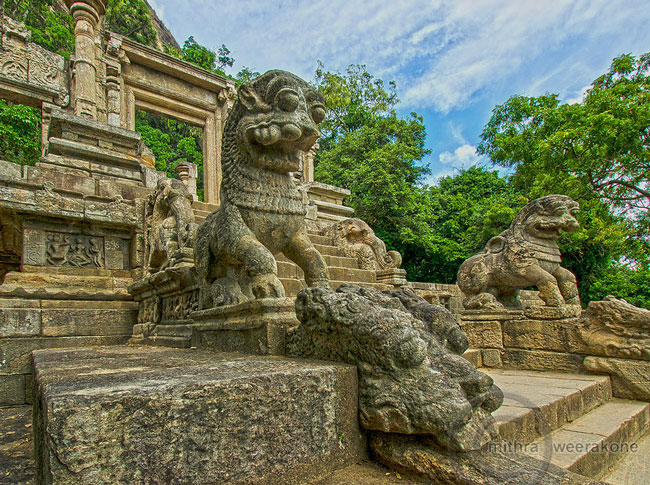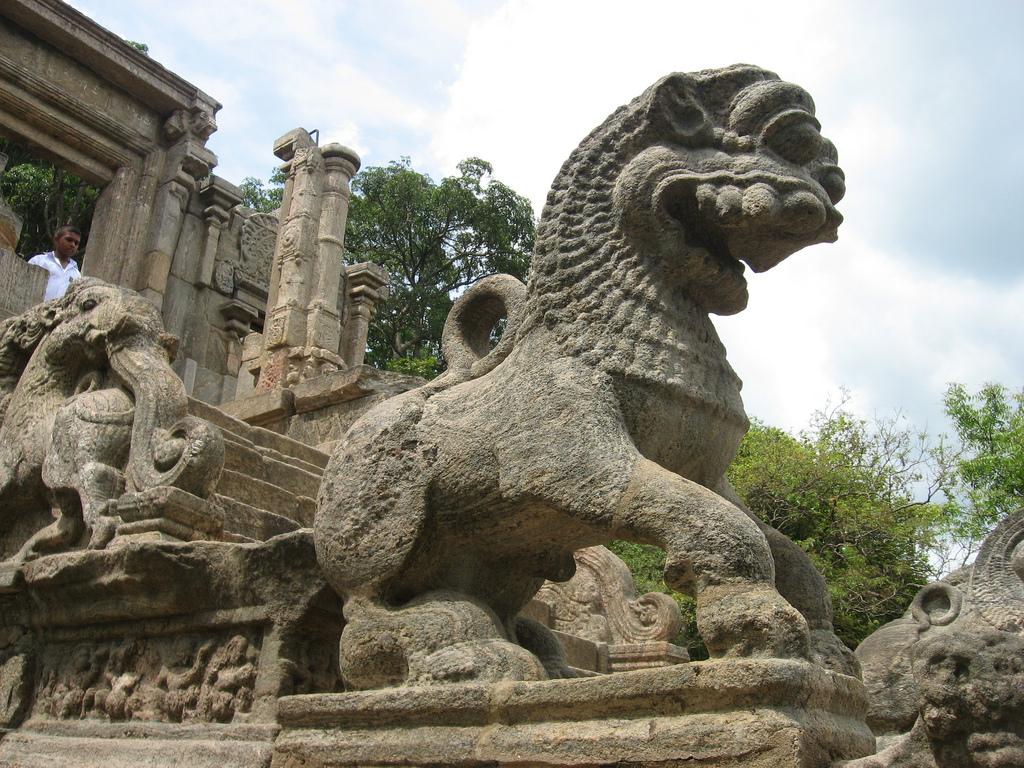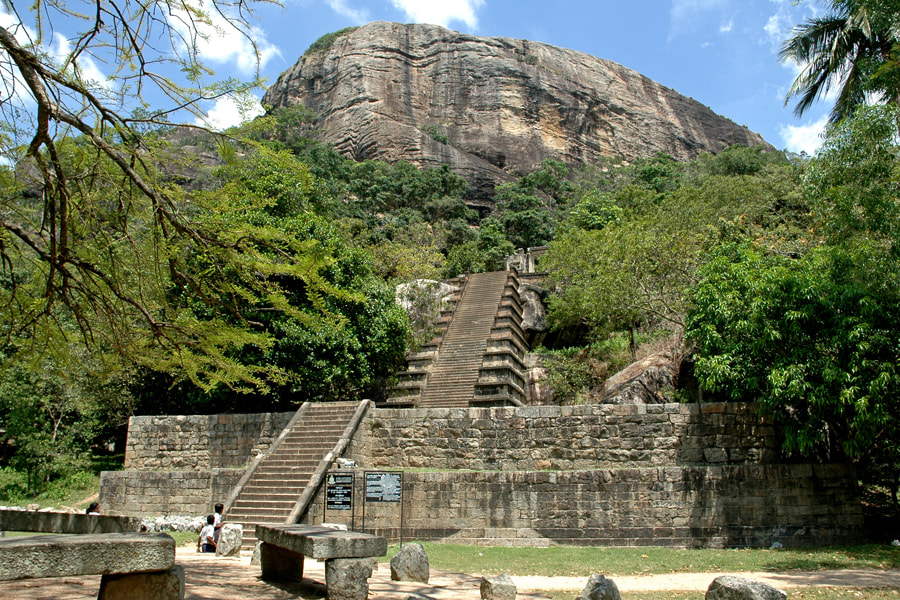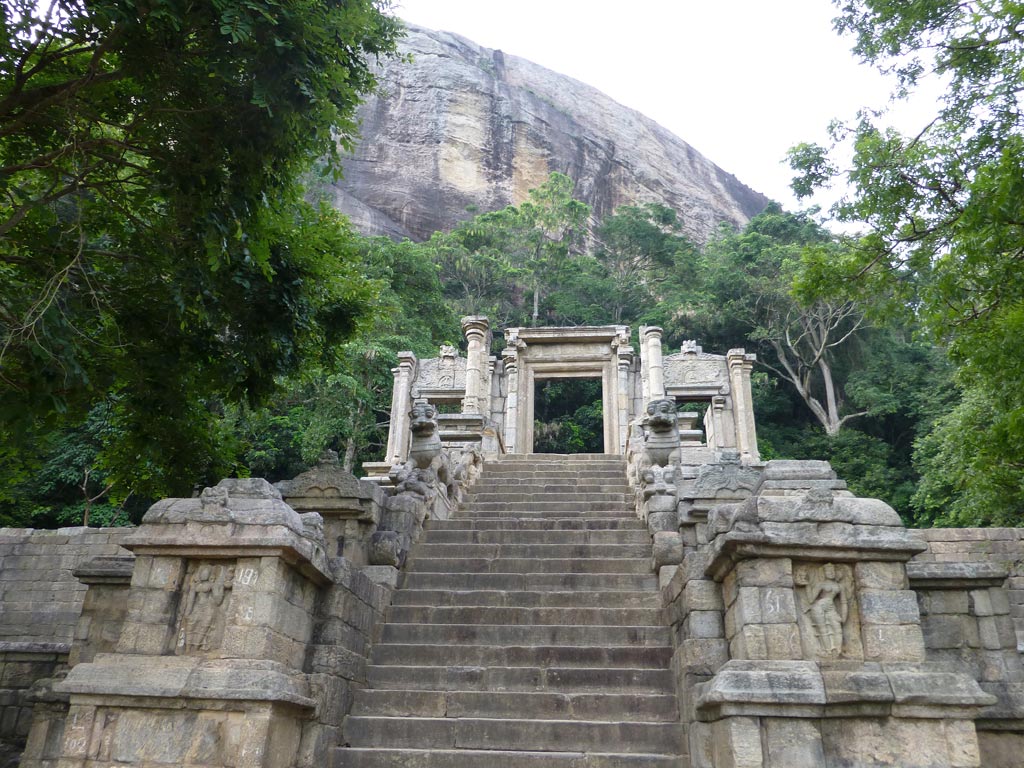Yapahuwa: The Fortress of the Sacred Tooth Relic

Yapahuwa Rock Fortress stands as one of Sri Lanka’s most dramatic medieval capitals, combining military fortification with architectural splendor. Rising approximately 90 meters above the surrounding plains in the Kurunegala District, this imposing rock citadel served briefly but significantly as Sri Lanka’s royal capital during the turbulent 13th century. Most notably, Yapahuwa housed the Sacred Tooth Relic of the Buddha, making it both a political and spiritual center of the kingdom.
Today, Yapahuwa is celebrated primarily for its magnificent ornamental stairway—considered one of the finest examples of medieval Sinhalese stone carving and architectural decoration. This breathtaking staircase, adorned with exquisite sculptures and intricate carvings, represents the pinnacle of 13th-century artistic achievement and remains remarkably well-preserved.
Historical Context and Significance
Following the decline of Polonnaruwa in the early 13th century due to repeated South Indian invasions, Sri Lankan kings sought more defensible capitals in the island’s interior. Dambadeniya served as capital from 1220 to 1272, but King Buwanekabahu I (1272-1284) chose to relocate the capital to Yapahuwa around 1272, seeking even greater security.
The selection of Yapahuwa was strategic—the massive rock outcrop provided natural fortification, its elevated position offered commanding views of approaching enemies, and its location allowed control over important trade routes connecting the northern and southern regions of the island. The king constructed a fortified palace complex atop the rock and surrounded it with defensive walls, moats, and ramparts.
The Sacred Tooth Relic
Yapahuwa’s greatest significance lies in its role as the custodian of the Sacred Tooth Relic of Lord Buddha. King Buwanekabahu I brought the relic from Dambadeniya and enshrined it in a specially constructed temple within the rock fortress, continuing the ancient tradition whereby possession of the tooth relic legitimized royal authority.
However, Yapahuwa’s tenure as guardian of the sacred relic was tragically brief. In 1284, following King Buwanekabahu’s death, the Pandyan forces from South India invaded and successfully captured Yapahuwa. The invaders seized the Sacred Tooth Relic and carried it to their capital in South India—a devastating blow to Sinhalese sovereignty and Buddhist faith.
This loss traumatized the kingdom. Desperate diplomatic efforts and military campaigns were undertaken to recover the relic. Eventually, through negotiations and possibly military pressure, the tooth relic was returned to Sri Lanka, though Yapahuwa was abandoned as the capital. The kingdom’s center subsequently moved to Kurunegala and later to other locations, beginning a period of shifting capitals that characterized medieval Sri Lankan history.
The Magnificent Ornamental Stairway
Yapahuwa’s crowning architectural glory is its spectacular ornamental stairway, which ascends the rock face to the former palace and temple complex. This monumental staircase represents one of the finest achievements of medieval Sinhalese sculpture and stone carving.
Architectural Design: The stairway rises in stages through an elaborately decorated stone portal (vahalkada), featuring multiple tiers of carved decoration. The entrance pavilion showcases the sophisticated architectural vocabulary of 13th-century Sri Lanka, combining structural elements with sculptural ornamentation in harmonious proportion.
Stone Carvings and Sculptures: The stairway is adorned with extraordinary stone carvings displaying remarkable artistic skill:
- Makara Balustrades: The stairway’s balustrades feature magnificent makara (mythical sea creatures) rendered with dynamic energy and intricate detail. These dragon-like creatures, with elaborate scrollwork emerging from their mouths, demonstrate the sculptors’ mastery of decorative composition.
- Dwarfs and Atlantean Figures: Muscular dwarf figures (gana) appear to support architectural elements, their expressive faces and powerful bodies carved with anatomical precision and artistic vitality.
- Dancing Figures: Graceful dancers in various poses adorn panels, their movements frozen in stone with remarkable naturalism. These figures likely represent celestial apsaras or court dancers, showcasing the cultural importance of dance in medieval court life.
- Floral and Geometric Patterns: Elaborate decorative borders featuring lotus motifs, scrollwork, and geometric designs frame the sculptural elements, creating visual richness without overwhelming the composition.
- Guardian Figures: Stone sentinels stand at strategic points, their stern expressions and formal poses emphasizing the sacred and royal nature of the precinct they protect.
Artistic Influences: The Yapahuwa stairway displays clear South Indian (Dravidian) artistic influences, particularly from the Pandyan artistic tradition, while maintaining distinctive Sinhalese characteristics. This synthesis reflects the cultural exchanges and conflicts that characterized 13th-century Sri Lanka.
The quality of carving, sophistication of design, and state of preservation make this stairway one of Sri Lanka’s most important sculptural monuments, often compared favorably with the finest temple architecture of South India.
The Rock Fortress
The massive granite rock that forms Yapahuwa’s natural defense rises dramatically from flat terrain, its steep faces requiring minimal additional fortification. The fortress complex encompassed several defensive and functional zones:
Lower Defenses: The base of the rock was protected by ramparts, moats, and defensive walls that enclosed a substantial area. Gates and guardhouses controlled access to the upper levels.
The Palace Complex: Atop the rock plateau stood the royal palace, administrative buildings, and residential quarters. Though only foundations and scattered ruins survive, archaeological evidence indicates substantial brick and stone structures occupied the summit.
The Temple of the Tooth Relic: A specially constructed shrine housed the sacred tooth relic during Yapahuwa’s brief tenure as its custodian. The temple’s location on the rock symbolized the elevation of Buddhist sacred objects above the terrestrial realm.
Water Management: Cisterns carved into the rock collected and stored rainwater, ensuring water supply during sieges. The sophisticated water management system demonstrates the technical knowledge required to maintain a fortress-palace on an isolated rock.
Cave Shrines and Monasteries
Around the base of the rock and in natural caves and rock shelters, Buddhist monastic complexes developed. These cave temples, some predating the royal capital, contain Buddha images, ancient paintings, and inscriptions that provide historical information about the site’s religious significance.
The Yapahuwa Rajamaha Vihara, located near the rock’s base, continues to function as an active Buddhist temple, maintaining religious traditions that span centuries. The temple houses ancient Buddha statues and serves the local community, connecting Yapahuwa’s medieval glory with contemporary Buddhist practice.
Archaeological Features
Archaeological investigations at Yapahuwa have revealed numerous features illuminating medieval Sri Lankan civilization:
Inscriptions: Stone inscriptions found at the site provide valuable historical data about the kingdom’s administration, religious donations, and political events.
Architectural Fragments: Scattered carved stones, pillars, and decorative elements suggest the original buildings’ grandeur and aesthetic sophistication.
Foundations and Structures: Remains of defensive walls, gateways, and building foundations reveal the fortress’s layout and construction techniques.
Artifacts: Excavations have uncovered pottery, coins, and other objects that shed light on daily life, trade connections, and material culture of 13th-century Sri Lanka.
Chinese Connection
Yapahuwa holds a unique place in Sri Lankan-Chinese relations. Historical records indicate that the Chinese traveler Wang Dayuan visited Yapahuwa in the 14th century and left descriptions of the fortress. Additionally, some scholars suggest that Chinese architectural and decorative influences may be discernible in Yapahuwa’s ornamental stairway, reflecting maritime trade connections between Sri Lanka and China during this period.
Comparison with Other Rock Fortresses
Yapahuwa invites comparison with Sri Lanka’s other famous rock fortresses, particularly Sigiriya. While Sigiriya is larger, older, and more famous, Yapahuwa offers its own distinctive character:
- Scale: Yapahuwa’s rock is smaller and less dramatic than Sigiriya but still impressively imposing
- Ornamentation: Yapahuwa’s decorative stairway surpasses Sigiriya in sculptural ornamentation
- Historical Role: Unlike Sigiriya’s brief moment of glory under one king, Yapahuwa functioned as capital during a crucial transitional period
- Religious Significance: Yapahuwa’s role as custodian of the tooth relic gives it unique spiritual importance
Conservation Status
The Central Cultural Fund and Department of Archaeology conduct ongoing conservation work at Yapahuwa, focusing on:
- Structural Stabilization: Protecting the ornamental stairway and architectural remains from weathering and structural deterioration
- Vegetation Management: Controlling plant growth that threatens stone structures while maintaining the site’s natural beauty
- Documentation: Comprehensive recording of carvings, inscriptions, and architectural features
- Site Development: Improving visitor facilities while preserving archaeological integrity
The ornamental stairway has undergone careful conservation to preserve its intricate carvings. Protective measures shield vulnerable sculptural elements from weathering while maintaining public access for appreciation and study.
Visitor Experience
Yapahuwa offers visitors a more intimate and less crowded experience than Sri Lanka’s major heritage sites. The climb to the summit, while requiring moderate effort, is less strenuous than Sigiriya and provides rewarding views and archaeological discoveries at every level.
The Ascent: Visitors approach through the lower defensive walls, experiencing the fortress’s military architecture before encountering the magnificent ornamental stairway. The transition from functional fortification to decorative splendor creates dramatic impact.
The Ornamental Stairway: Time spent appreciating the stairway’s sculptural details rewards careful observation. The play of light and shadow across the intricate carvings changes throughout the day, with early morning and late afternoon providing optimal viewing conditions.
The Summit: Though the summit structures are largely ruined, the plateau offers panoramic views of the surrounding countryside, ancient reservoir systems, and the approaching pathways that once brought emissaries, pilgrims, and armies to this royal citadel.
The Cave Temples: Exploring the cave shrines at the rock’s base provides insight into the site’s religious continuity and allows visitors to see ancient Buddha images in their original devotional context.
Cultural Significance
Yapahuwa represents a crucial chapter in Sri Lankan medieval history—a period of transition, foreign threats, and adaptive strategies. The fortress embodies the resilience of Sinhalese kingdoms facing external pressures, the continuing importance of the tooth relic in legitimizing sovereignty, and the artistic creativity that flourished even during politically turbulent times.
The loss and recovery of the Sacred Tooth Relic from Yapahuwa became embedded in national memory as a story of crisis and redemption, emphasizing the relic’s central role in Sri Lankan Buddhist identity.
Architectural Legacy
The Yapahuwa ornamental stairway influenced subsequent Sri Lankan architectural decoration. Its synthesis of functional architecture with elaborate sculptural ornamentation established aesthetic standards that later kingdoms sought to emulate. The technical excellence of its stone carving demonstrates the high level of artistic training and workshop organization that existed in medieval Sri Lanka.
Yapahuwa stands as a testament to a brief but significant moment in Sri Lankan history—when a mighty rock fortress became the kingdom’s capital and guardian of its most sacred treasure. Though its political prominence lasted less than two decades, the magnificent stairway that ascends its face ensures that Yapahuwa’s artistic legacy endures, inspiring wonder and admiration seven centuries after its royal inhabitants departed.








*Photo credits go to the respective owners
